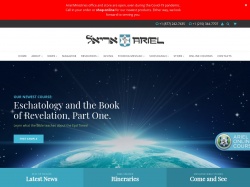This week’s Torah portion covers the last three plagues of Egypt, but it is also full of some of the first real legal legislation in the Torah.
We find detailed instructions on the calendar, the Pesach offering, the Festival of Matzot, and the consecration of the firstborn. In the final verses of the portion we even find instructions on tefillin:
And it shall be to you as a sign on your hand and as a memorial between your eyes, that the law of the LORD may be in your mouth. (Exodus 13:9)
It shall be as a mark on your hand or frontlets between your eyes, for by a strong hand the LORD brought us out of Egypt. (Exodus 13:16)
Although in context this seems to refer metaphorically to the story of the exodus, from a very early period these verses, coupled with the injunctions in Deuteronomy 6:8 and 11:18, were understood by the Jewish people as a literal commandment of tefillin.
Tefillin are small, black, leather boxes with parchments of Scripture folded inside them. Observant Jewish men attach these boxes to their foreheads and arms with leather straps during morning prayers. In the days of the Master, Jewish men wore their tefillin all day long.
One of the most curious things about tefillin is the presence of the Hebrew letter shin (ש) on the two sides of the head tefillin. While the shin on the right of the head tefillin is in the standard Hebrew form with three strokes, the left side has one with four strokes. This is the only place that such a shin appears.

Illustration of shin on embossed on tefillin, taken from Tefillin: A Study on the Commandment of Tefillin, published by First Fruits of Zion.
While commentators have suggested various reasons for this four-pronged shin, I recently came across an interpretation from Rabbi David Katz that was particularly intriguing to me. He states that the “mystical four-headed shin … alludes to the future status of gerim [strangers] amongst Israel.” [1] What does he mean by this? He explains further in an audio teaching where he references the familiar quadripartite pattern of Priest, Levite, Israelite, and God-fearer. [2] We see this in the Psalms:
O house of Israel, bless the LORD! O house of Aaron, bless the LORD! O house of Levi, bless the LORD! You who fear the LORD, bless the LORD! (Psalm 135:19-20)
The “house of Israel” refers to the regular Israelite, the “house of Aaron” refers to the priests, the “house of Levi” refers to the Levites, and those “who fear the LORD” refers to those from the nations who have joined themselves to the God of Israel—the God-fearers, the strangers who dwell among you (gerim). The Midrash suggests that because these God-fearers do not have a house they are exceedingly pious:
Why does the Holy One, blessed be He, love the righteous? Because their worth is due neither to heritage nor to family. You find that the priests constitute a father’s house and the Levites constitute a father’s house; for it says, “O house of Aaron, bless the Lord; O house of Levi, bless the Lord” (Psalm 135:19). If a man desires to be a priest, he cannot be one; a Levite, he cannot be one. Why? Because his father was neither a priest nor a Levite. But if a man, even a Gentile, desires to be righteous, he can be so, because the righteous do not constitute a father’s house. For this reason it says, “You that fear the Lord, bless the Lord” (Psalm 135:20). It does not say: “O house of those that fear the Lord,” but “You that fear the Lord,” for these do not constitute a father’s house, but have voluntarily come forward and loved the Holy One, blessed be He. (Numbers Rabbah 8:2)
On the other hand, Rabbi Katz suggests that we can say these Gentiles who love HaShem are from the house of Noah or the house of Shem. So then riffing off Rabbi Katz’s idea, the four-headed shin on the head tefillin represents the four houses or groups that make up the “commonwealth of Israel” (Ephesians 2:12).
Bringing this full circle, let’s now take this back to our parashah. As we noted previously, this Torah portion deals with the exodus from Egypt and the first Passover. This is a uniquely Jewish experience. At the same time the presence of the tefillin commandment, which would later receive this prophetic four-headed shin, is another indicator that the exodus and Passover are not just about redeeming the Jewish people but that this was an important step in bringing salvation to the world at large. In other words, the exodus is a uniquely Jewish experience that has universal benefits—the redemption of all humanity.
Learn more about the mitzvah of tefillin from First Fruits of Zion’s book Tefillin: A Study of the Commandment of Tefillin.
Footnotes:
- Rabbi David Katz, “Gerim and the House of Prayer at Sinai,” n.p. [cited 8 December 2017]. Online: http://soulmazal.blogspot.com/2013/04/gerim-and-house-of-prayer-at-sinai.html
- Rabbi David Katz, Torah of Shem 7. https://www.youtube.com/watch?v=RyvG9S-o23w&index=7&list=PLw2PB0CJC7HTTWOOdo_Re18oObQ4cNa1Z.
Source: First Fruits of Zion



